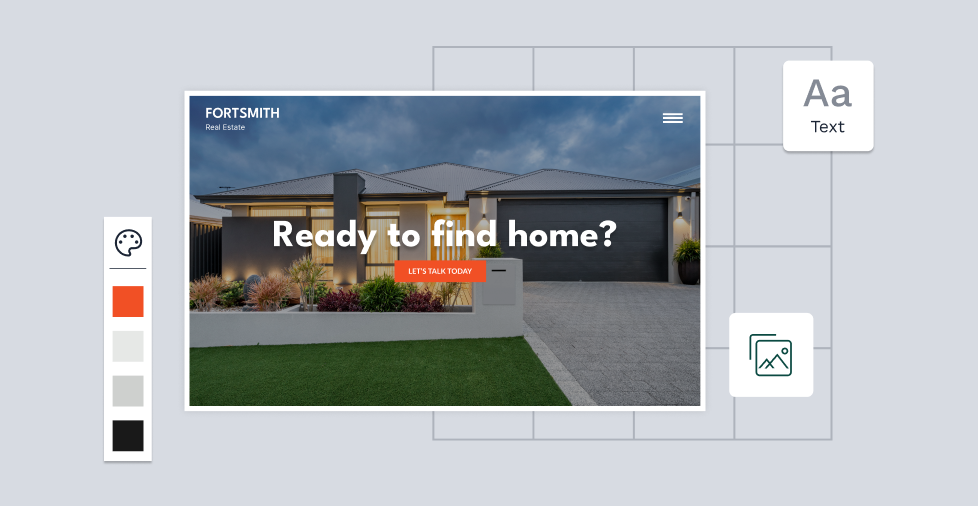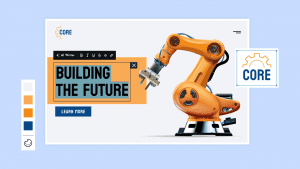Key takeaways:
- A professional real estate website is key to increasing visibility, generating leads, and building trust with buyers and sellers.
- Features like Internet Data Exchange (IDX) / Multiple Listing Service (MLS) integration, advanced search filters, and local SEO can significantly boost traffic and conversion rates.
- Strategic design, secure hosting, and compelling content position agents and brokers as trusted market experts.
In 2023, 52% of buyers found the home they ultimately purchased online. Your website is more than a simple brochure; it is a central hub for connecting with potential buyers and sellers.
For agents, brokers, and agencies, a professional and easy-to-use site often shapes a client’s first impression. Without one, there is a higher chance of losing business to competitors with a strong online presence.
Imagine attracting leads 24/7, showcasing properties with high-quality visuals, and positioning yourself as the go-to expert in your area.
This step-by-step guide will show you how to build a real estate website that draws in clients, highlights your listings, and supports your business growth.
Steps:
- Define your website’s goals and audience
- Choose the right platform and tools
- Pick a professional domain name
- Secure, reliable hosting and SSL
- Design your real estate website for trust and conversion
- Add must-have real estate website features
- Create compelling real estate content
- Optimize for search engines (SEO)
- Test, launch, and maintain your site
Step 1. Define your website’s goals and audience
A clear purpose is the foundation of a successful real estate website. Your goals influence everything from design, layout, the features you prioritize, and the content you publish.
For example, you may want to:
- Showcase MLS listings for a specific neighborhood
- Build a personal brand as a local market expert
- Capture leads through property alerts, contact forms, or newsletter sign-ups
Understanding your audience helps refine these goals. First-time buyers may look for financing tips and neighborhood guides. Luxury clients might expect high-resolution imagery, virtual tours, and a more refined design. Commercial investors often value market data, zoning information, and return-on-investment insights.
Defining both your goals and audience early ensures every design choice supports the results you want to achieve.
Step 2. Choose the right platform and tools
The platform you choose affects how easily you can build, manage, and grow your real estate website. Real estate-specific platforms such as Placester, AgentFire, Easy Agent PRO, and iNCOM include property listings and lead management tools.
Look for options with IDX/MLS integration, so property listings update automatically with accurate, real-time data. This keeps your site relevant and encourages visitors to return.
A note on IDX/MLS with our platform: Many popular all-in-one website builder solutions like Network Solutions don’t offer a pre-built IDX/MLS element directly in the builder interface. Alternatively, it’s theoretically possible to integrate listings using our HTML Embed widget with custom code from your MLS service. We also provide a Zillow social button.
Other factors to weigh include:
- Customization for branding and layout.
- Mobile optimization for buyers browsing on phones or tablets.
- SEO features to help local clients find your listings online.
Platforms that combine these features with reliable hosting and design flexibility give you a stronger start. Network Solutions is one example, offering mobile-friendly templates, easy customization, and dependable performance that support real estate marketing needs.
Step 3. Pick a professional domain name
Your domain name is part of your brand. It should be short, easy to remember, and relevant to your location or market niche.
Strong choices often include the city or neighborhood you serve, such as “AustinLofts.com.” Avoid numbers, hyphens, and unusual spellings that confuse visitors or make the name harder to share. You can learn more tips for building a strong domain name from our choosing the right domain name for your business guide.
Once you decide on a name, register your domain quickly before someone else takes it.
Step 4. Secure, reliable hosting and SSL
Hosting affects your site’s speed, uptime, and overall performance. In real estate, a slow or unreliable site can frustrate potential clients and cause them to leave before exploring your listings.
Look for hosting that can handle traffic spikes, such as when you promote an open house or add a high-demand property.
An SSL certificate is just as important. It encrypts data sent through your site, protecting contact forms, client details, and other sensitive information. It also shows visitors that your site is secure, which can increase trust.
Consider options that combine hosting and SSL certificates so you can manage both in one place.
Step 5. Design your real estate website for trust and conversion
Site visitors often decide within seconds whether to explore further or click away. In a competitive real estate market, design is not just about looks. It is about building credibility and guiding visitors toward actions such as booking a showing or requesting more details.
These key design elements include:
- Clean layout
- High-quality images
- Clear property categories
- Search bar with filters
- Lead capture elements
- Consistent branding
- Trust signals
Clean layout
Keep pages uncluttered so the focus stays on your properties. Use white space strategically to make content easier to read and navigate.
High-quality images
Invest in professional photography or virtual staging. Clear, high-resolution images can make listings more appealing and improve perceived value.
Clear property categories
Organize listings into intuitive categories so visitors can browse by need. Use labels and menus that make sense to your target audience.
Search bar with filters
Offer search tools that let users filter by location, price range, property type, and amenities. Make sure it works seamlessly on mobile devices.
Lead capture elements
Add clear, clickable calls-to-action on every property page. Buttons like “Schedule a Showing” or “Request Info” should stand out without overwhelming the design.
Consistent branding
Your brand identity should be immediately recognizable. Use your logo, color palette, and typography consistently across all pages.
Trust signals
Showcase positive reviews, industry certifications, and any awards to build credibility and reassure visitors.
Step 6. Add must-have real estate website features
A real estate website without the right features can feel like an empty storefront. It may look appealing but fail to give buyers and sellers the tools they need. The right mix of features keeps visitors engaged, helps them make decisions faster, and increases the chances they will contact you.
Core features to include:
- Property listings with media
- Advanced search and filtering
- Neighborhood guides
- Lead capture tools
- Mortgage calculator
- IDX/MLS integration
Property listings with media
Showcase each property with professional images, interactive 3D tours, and video walkthroughs. These help buyers visualize the space before visiting.
Advanced search and filtering
Allow users to refine results by criteria that matter most to them. Keep filters simple and quick to use.
Neighborhood guides
Offer detailed local insights that go beyond the property. Including schools, parks, shopping, public transit, and lifestyle details.
Lead capture tools
Integrate contact forms, live chat, and newsletter sign-ups to gather visitor information for follow-up.
Mortgage calculator
Provide a simple calculator so buyers can understand their financing options and budget.
IDX/MLS integration
Connect your site to MLS feeds, so listings update automatically. This keeps your content accurate and reduces manual work. In Network Solutions, you can integrate MLS listings using our HTML Embed widget by adding a custom code from your MLS service. For details, see our HTML Injection Feature Guide.
Step 7. Create compelling real estate content
Content helps attract visitors, improve search rankings, and position you as a trusted local expert. Quality resources give buyers and sellers a reason to return to your site and share your information with others.
Content ideas for real estate websites:
- Blog topics
- Video
- Downloadable guides
Blog topics
Cover market trends, home staging tips, and local events. Write posts that answer common questions, such as “What to Know Before Buying in [City]” or “Best Neighborhoods for First-Time Buyers.”
Video
Produce short videos to introduce yourself, provide virtual property tours, or explain the buying and selling process. Videos build trust and help clients connect with you on a personal level.
Downloadable guides
Offer resources like buyer and seller checklists, financing guides, and quarterly market reports. Use these as lead magnets by collecting visitor emails in exchange for downloads.
Step 8. Optimize for search engines (SEO)
Search engine optimization (SEO) increases the chances of your site appearing when people search for properties or agents in your area. A strong local SEO strategy helps connect you with the right audience at the right time.
The following are important SEO steps for real estate websites:
- Local keywords in copy and meta tags
- Metadata optimization with real estate terms
- Mobile responsiveness and speed optimization
- Google Business Profile setup and updates
Local keywords in copy and meta tags
Add city, neighborhood, and property type keywords to page titles, descriptions, and on-page copy. Examples include “Luxury condos in Miami” or “Homes for sale in Denver.”
Metadata optimization with real estate terms
Write descriptive title tags and meta descriptions that encourage clicks. Include relevant real estate phrases that align with search intent.
Mobile responsiveness and speed optimization
Over half of property searches happen on mobile devices, according to NAR data. Use a responsive design and compress images to improve loading speed.
Google Business Profile setup and updates
Claim and maintain your Google Business Profile with accurate contact details, service areas, and high-quality photos. Updated profiles have a better chance of appearing in Google’s local pack results.
Step 9. Test, launch, and maintain your site
A polished launch creates a strong first impression, and regular upkeep keeps your site performing well over time. Treat your website as an evolving tool that grows with your business.
Final steps before and after launch:
- Test all pages and features
- Gather feedback from others
- Monitor performance regularly
Test all pages and features
Click through every page to make sure links work, forms submit properly, and images display correctly. Test on multiple devices and browsers for consistent performance.
Gather feedback from others
Ask colleagues, friends, or past clients to navigate the site. Use their feedback to fix any confusing layouts or missing information.
Monitor performance regularly
Review analytics to track traffic, user behavior, and lead conversions. Update listings, refresh content, and resolve technical issues to keep your site current.
Get found by more buyers and sellers
In real estate, visibility can determine how quickly you close deals. A well-built website puts your listings in front of serious buyers, keeps your brand top of mind for sellers, and positions you as the go-to expert in your market.
With the right domain, secure hosting, and SSL protection, you can create a site that ranks well in local searches, loads fast on any device, and gives visitors the confidence to contact you. Network Solutions offers the tools to make that happen while giving you the flexibility to showcase properties the way you want.
Connect with our Help Center to begin creating a real estate website that attracts and converts clients.
Frequently asked questions
Costs can range from under $500 for a DIY template-based site to several thousand dollars for a custom design with advanced features. Expenses include domain registration, hosting, SSL certificates, and any paid tools or plugins.
Yes, especially if you want full control over your brand and leads. Many website builders make it possible to launch a professional site without coding experience.
The best choice depends on your budget, technical skills, and feature needs. Look for platforms that offer IDX/MLS integration, mobile-friendly templates, and real estate-focused customization options.
There is no guaranteed income, but a well-optimized site can help generate consistent leads. Combine your website with local SEO, targeted ads, high-quality content, and strong follow-up systems to increase your chances of high earnings.




